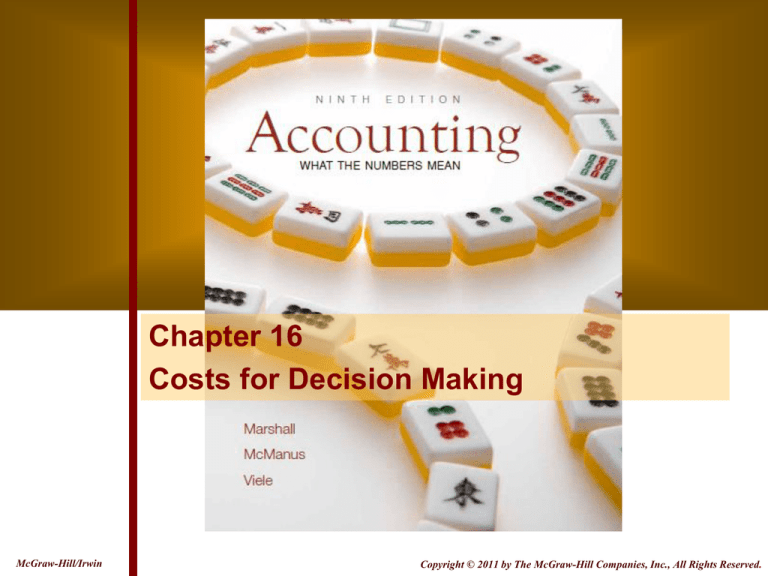
16-1
1-1
© 2008 The McGraw-Hill Companies, Inc., All Rights Reserved.
Chapter 16
Costs for Decision Making
McGraw-Hill/Irwin
McGraw-Hill/Irwin
16-1
© 2008
The ©
McGraw-Hill
Companies,
Inc., All
Reserved.
Copyright
2011 by The McGraw-Hill
Companies,
Inc.,Rights
All Rights
Reserved.
16-2
1-2
LO1
Relevant Cost Information
Relevant
Irrelevant
Differential Cost -- will differ
according to alternative activities
being considered.
Allocated Cost -- a common cost that
has been arbitrarily assigned to a
product or activity.
Opportunity Cost -- income foregone
by choosing one alternative over
another.
Sunk Cost -- has already been incurred
and will not change.
McGraw-Hill/Irwin
16-2
© 2008 The McGraw-Hill Companies, Inc., All Rights Reserved.
16-3
1-3
Opportunity Cost
LO1
Example: If you were not
attending college, you could
be earning $20,000 per year.
Your opportunity cost of
attending college for one
year is $20,000.
Opportunity costs are not recorded in the
accounting records, but are relevant to
decisions because they are a real sacrifice.
McGraw-Hill/Irwin
16-3
© 2008 The McGraw-Hill Companies, Inc., All Rights Reserved.
16-4
1-4
LO3
The Special Pricing Decision
The decision to accept additional
business should be based on
incremental costs and incremental
revenues.
Incremental amounts are those
amounts that occur if the
company decides to accept the
new business.
McGraw-Hill/Irwin
16-4
© 2008 The McGraw-Hill Companies, Inc., All Rights Reserved.
16-5
1-5
LO3
The Make or Buy Decision
The relevant cost of making a component
is the cost that can be avoided by buying
the component from an outside supplier.
Decision rule: Costs avoided must be
greater than outside supplier’s price to
consider buying the component.
McGraw-Hill/Irwin
16-5
© 2008 The McGraw-Hill Companies, Inc., All Rights Reserved.
16-6
1-6
LO3
Short-Term Allocation
of Scarce Resources
Managers often face the problem of deciding
how scarce resources are going to be utilized.
Usually, fixed costs are not affected by this
particular decision, so management can focus
on maximizing total contribution margin.
McGraw-Hill/Irwin
16-6
© 2008 The McGraw-Hill Companies, Inc., All Rights Reserved.
16-7
1-7
LO4
Capital Budgeting
Outcome
is uncertain.
Large amounts of
money are usually
involved.
Capital budgeting:
Analyzing alternative longterm investments and deciding
which assets to acquire or sell.
Decision may be
difficult or impossible
to reverse.
McGraw-Hill/Irwin
Investment involves a
long-term commitment.
16-7
© 2008 The McGraw-Hill Companies, Inc., All Rights Reserved.
16-8
1-8
LO4
Investment Decision
Special Considerations
I will choose the
project with the most
profitable return on
available funds.
Limited
Investment
Funds
?
?
?
McGraw-Hill/Irwin
Plant
Expansion
New
Equipment
Office
Renovation
16-8
© 2008 The McGraw-Hill Companies, Inc., All Rights Reserved.
16-9
1-9
Cost of Capital
LO6
•
The firm’s cost of capital is
usually regarded as the most
appropriate choice for the
discount rate used to calculate
the present value of the
investment proposal being
analyzed.
•
The cost of capital is the average
rate of return the company must
pay to its long-term creditors and
stockholders for the use of their
funds.
McGraw-Hill/Irwin
16-9
© 2008 The McGraw-Hill Companies, Inc., All Rights Reserved.
16-10
1-10
LO6
Capital Budgeting Techniques
Methods that use present value analysis:
• Net present value (NPV).
• Internal rate of return (IRR).
Methods that do not use present value analysis:
• Payback.
• Accounting rate of return.
McGraw-Hill/Irwin
16-10
© 2008 The McGraw-Hill Companies, Inc., All Rights Reserved.
16-11
1-11
LO7
Net Present Value (NPV)
Chose a discount rate – the
minimum required rate of return.
Calculate the present
value of cash inflows .
Calculate the present
value of cash outflows .
NPV =
McGraw-Hill/Irwin
–
16-11
© 2008 The McGraw-Hill Companies, Inc., All Rights Reserved.
16-12
1-12
LO7
Net Present Value (NPV)
General decision rule . . .
If the Net Present
Value is . . .
Then the Project is . . .
Positive . . .
Acceptable, since it promises a
return greater than the cost of
capital.
Zero . . .
Acceptable, since it promises a
return equal to the cost of
capital.
Negative . . .
Not acceptable, since it
promises a return less than the
cost of capital.
McGraw-Hill/Irwin
16-12
© 2008 The McGraw-Hill Companies, Inc., All Rights Reserved.
16-13
1-13
LO7
Internal Rate of Return (IRR)
The actual rate of return that will be
earned by a proposed investment.
The interest rate that equates the present
value of inflows and outflows from an
investment project – the discount rate at
which NPV = 0.
If annual cash inflows are unequal, trial and error
solution will result if present value tables are used.
Sophisticated business calculators and electronic
spreadsheets can be used to easily solve these
problems.
McGraw-Hill/Irwin
16-13
© 2008 The McGraw-Hill Companies, Inc., All Rights Reserved.
16-14
1-14
LO8
Some Analytical Considerations
Sensitivity analysis and post audits are helpful in dealing with
estimates.
Cash flows far into the future are often not considered because of
uncertainty and a small impact on present values.
Cash flows are assumed to occur
at the end of the year.
Some projects will require additional investments over time.
Often, after-tax cash flow can be estimated by adding back
depreciation expense (a noncash item) to net income.
Increased working capital is initially treated as an additional
investment (cash outflow) and as a cash inflow if recovered at
the end of the project’s life.
Least cost projects, often required by law, will have negative
NPV’s.
McGraw-Hill/Irwin
16-14
© 2008 The McGraw-Hill Companies, Inc., All Rights Reserved.
16-15
1-15
Payback Period
LO9
The payback period of an investment
is the number of years it will take to
recover the amount of the investment.
Managers prefer investing in projects
with shorter payback periods.
Ignores the
time value
of money.
McGraw-Hill/Irwin
Ignores cash
flows after
the payback
period.
16-15
© 2008 The McGraw-Hill Companies, Inc., All Rights Reserved.
16-16
1-16
Accounting Rate of Return
L O 10
The accounting rate of return focuses on
accounting income instead of cash flows.
Accounting
rate of return
McGraw-Hill/Irwin
=
Operating income
Average investment
16-16
© 2008 The McGraw-Hill Companies, Inc., All Rights Reserved.




